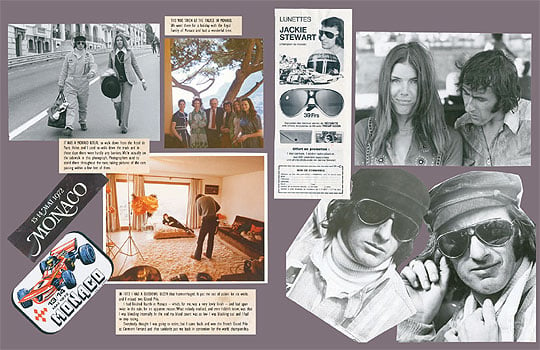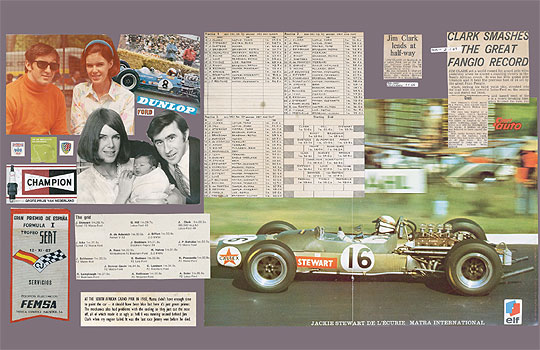
‘Collage, Jackie Stewart’s Grand Prix Album’ has just been published. Classic Driver spent some time with ‘JYS’ at the book’s London launch. The 208-page book, published as a collectors’ edition limited to 1500 signed copies by Genesis Publications, is an edited facsimile of the 17 scrapbooks maintained by his wife, Helen, during the great Scot’s driving (and shooting) heydays up to his retirement in 1973.
A review of ‘Collage’ can be read elsewhere on Classic Driver. Taking the opportunity of a brief one-to-one with Sir Jackie, we asked him to turn the clock back to 1964, when he tested an F3 Cooper for Tyrrell Racing at Goodwood.
Demolishing Bruce McLaren’s testing times, he has been described as achieving this ‘without looking bothered’. Was this really the case?
“No, I wouldn’t have known any better. I didn’t know anything – I’d never driven a single-seater in my life before. I knew Goodwood, which was to my advantage having had the lap record for sportscars in a Cooper Monaco, and that’s what excited Ken Tyrrell’s interest, but I did not know what my times were and I did not know I was going faster than Bruce. So I think you’d have to say it was naïveté.”

So it wasn’t a case of fearlessness?
“No, not at all. The one thing you don’t do when you get a test drive is go and crash a car. In fact, you don’t want to spin it, really. In those days you seldom spun a car without hitting something.”
Is it necessary nowadays for young drivers, when given that once-in-a-lifetime break, to really go for it?
“I think you’ve got to see them in a car. It does not matter what their track record is. Whatever you think, there is pressure: not necessarily to go fast but to impress. It doesn’t matter if you’re not the fastest on the day if the teams perceive that you would be somebody appropriate... but it's important to give good, clear, descriptive feedback to the engineers.
“There are an awful lot of good racing drivers who do not handle pressure well, and it’s mind-management rather than natural skill or ability that matters.

“The ones that do are usually spontaneously quick – and sometimes unspectacular.”
Since that day at Goodwood, Stewart enjoyed an unbroken single-seater career. He also drove the very best saloons and sportscars in Europe, as well as at Indianapolis and in the Can Am. Looking at what are now desirable collectors’ cars, what memories does he have of racing outside F1?
“Oh, many, from a P4 Ferrari, which was the most beautiful sports-racing car that’s ever been built, to the Lotus Cortina, which was probably the most difficult car I drove. Even a Lotus Elan was terribly difficult, but nevertheless very fast. The lightweight E-type I drove for John Coombs was a classic of its time, as was the Ferrari 275 LM that I drove quite a bit for Maranello Concessionaires, and David McKay in Australia. That last one is now owned by Ralph Lauren, by the way. There is also the Tojeiro-Buick and Tojeiro-Ford [both Ecurie-Ecosse cars – SW] – these were character-builders!
“And Formula 2 cars: the Matra was fantastic.”

Do modern F1 drivers miss out on this variety?
“Yes. I think they would enjoy it. I think they would find it recreational. I doubt that it would do anything against their career - they don’t actually drive very much anymore. They are doing 19 Grands Prix but not the testing we did. We did two Grands Prix distances a day for 16 days at Kyalami or Paul Ricard. Because the Ford DFV engine lasted forever! And still we were driving other cars, Capris for example.”
Sir Jackie was a part of the star-studded Cologne Capri team in the early 70s, alongside a young Jochen Mass, driving against the likes of Hans Stuck and Niki Lauda in a works BMW. Mass and Stuck are still active in racing today, as is former BRM team-mate Richard Attwood. Has Stewart ever been tempted to go back?
“No, never at all, and in actual fact I never did much like long-distance racing. Events like Le Mans, Sebring, Reims and the Nürburgring 1000Km. I still hold, apparently, the official GT lap record, in a 275 LM at Monthléry. In these races you never drove at ten tenths so I think I was a ‘100-metre’ versus ‘marathon’ runner, and there are drivers who were very consistent at six or seven tenths, but not at nine tenths. At Le Mans you cannot do on-the-limit motoring for 24 hours. Whether it’s Derek Bell, Jacky Ickx or Allan McNish, you get specialists who do it very well. Grand Prix drivers would not be as good as them in many ways.”

Safety. Was there one moment, such as the crash at Spa, where he thought “Now’s the time to stop all this”?
“The crash at Spa illustrated to me that there were no marshals to get me out of the car, and no ambulance to take me to the medical centre for a very long time. When I got there, I was laid in a stretcher on a floor with cigarette ends, and was then put in an ambulance to be taken to Liège because it was thought that I had a serious back injury. The police escort lost the ambulance, and the ambulance driver did not know how to get to Liège.
“That’s a comedy of errors, if you like, but when you think of today and the medical facilities at Silverstone, for example, at Grand Prix weekend, it’s probably better than at any university or hospital in the world for the type of injuries they should expect to have. The marshalling is so professional now and the British are the best in the world.

“The safety thing then was so obvious it had to be changed and, like so many things in life, it took someone to break the ice to make it happen. Whatever it was, it wasn’t intentional for me to be that person – it was just because I happened to be the man to beat by the time Jim Clark died. In that season of ’68, in April, May, June and July, we took out a Grand Prix driver on the same weekend of every month – not necessarily always in Grand Prix races, as Ludovico Scarfiotti died in a hillclimb: Jim Clark, Mike Spence, Ludovico Scarfiotti and Jo Schlesser.
“We then raced at the Nürburgring, on the sixth month, on the same weekend, and yet nobody was killed. It broke the string.”
One of the most dangerous circuits?
“The Nürburgring was THE most dangerous circuit, unquestionably, and one of the most challenging as well. It was a time when change had to occur. Had it not occurred there was a strong potential that the sport could have been mortally damaged by the wrong accidents occurring.”
Another 1955 Le Mans?
“We couldn’t afford another Le Mans.”

Paired with his son, Paul, Stewart competed in the 2010 Mille Miglia Storica in a 300 SL Gullwing. An enjoyable experience?
“Yes, I loved doing it with Paul, and David Coulthard and Mika Häkkinen were in the car in front of us, the prototype 300 SL Gullwing that did the Carrera Panamericana road race. So to keep up with Mika was quite a challenge at times... The crowd reception was unbelievable; I can’t remember ever having such a reception, and by some people who’d never seen me in their life before. I didn’t expect that.”
With fellow BRDC member and motor-racing knight Sir Stirling Moss a past competitor and one of the most famous winners, was it an event that caught his imagination at the time?
“Oh yes, absolutely. Stirling and the Marzotto brothers, for example, who used to shoot, too. Fangio, driving it on his own, without a navigator. Maglioli, I had his autograph...”

All heroes of a youthful Jackie Stewart?
“Of course. Farina and Villoresi, too – more autographs. The nostalgia of it is there, even though some of the roads we were on were not used at the time. Stirling’s drive was an epic one.”
After three World Championships, countless other trophies and a stellar business life since retirement, I had to ask if there was one thing Stewart would swap for all his achievements.
“Playing with the dogs! I like the simple things – like most people. I’m a family man, and I’m a dog man but, family aside, the knighthood from Her Majesty was a landmark of my life because it happened well after I’d finished my racing career. I’m such an admirer of Her Majesty.”

We had a look at the book, where each page must hold so many memories. I asked Sir Jackie to pick a favourite.
“Helen and I have been married for 48 years, and in the world I live in that demonstrates the strength of the family unit. This double page has me in a striped shirt at Villa d’Este, Cernobbio in 1969 [with Mark, Paul and Helen] after I had won the World Championship. Helen and I are looking into each other’s eyes [top left] the moment I’d won it.
“We were still with the car – that page is ‘it’.”
‘Collage, Jackie Stewart’s Grand Prix Album’ is priced at £295.00 plus shipping and is available worldwide from www.genesis-publications.com.
Text: Steve Wakefield
Photos: Classic Driver / Jesse Rose (Mille Miglia 300 SL) / Genesis Publications - All Strictly Copyright
ClassicInside - The Classic Driver Newsletter
Free Subscription!










